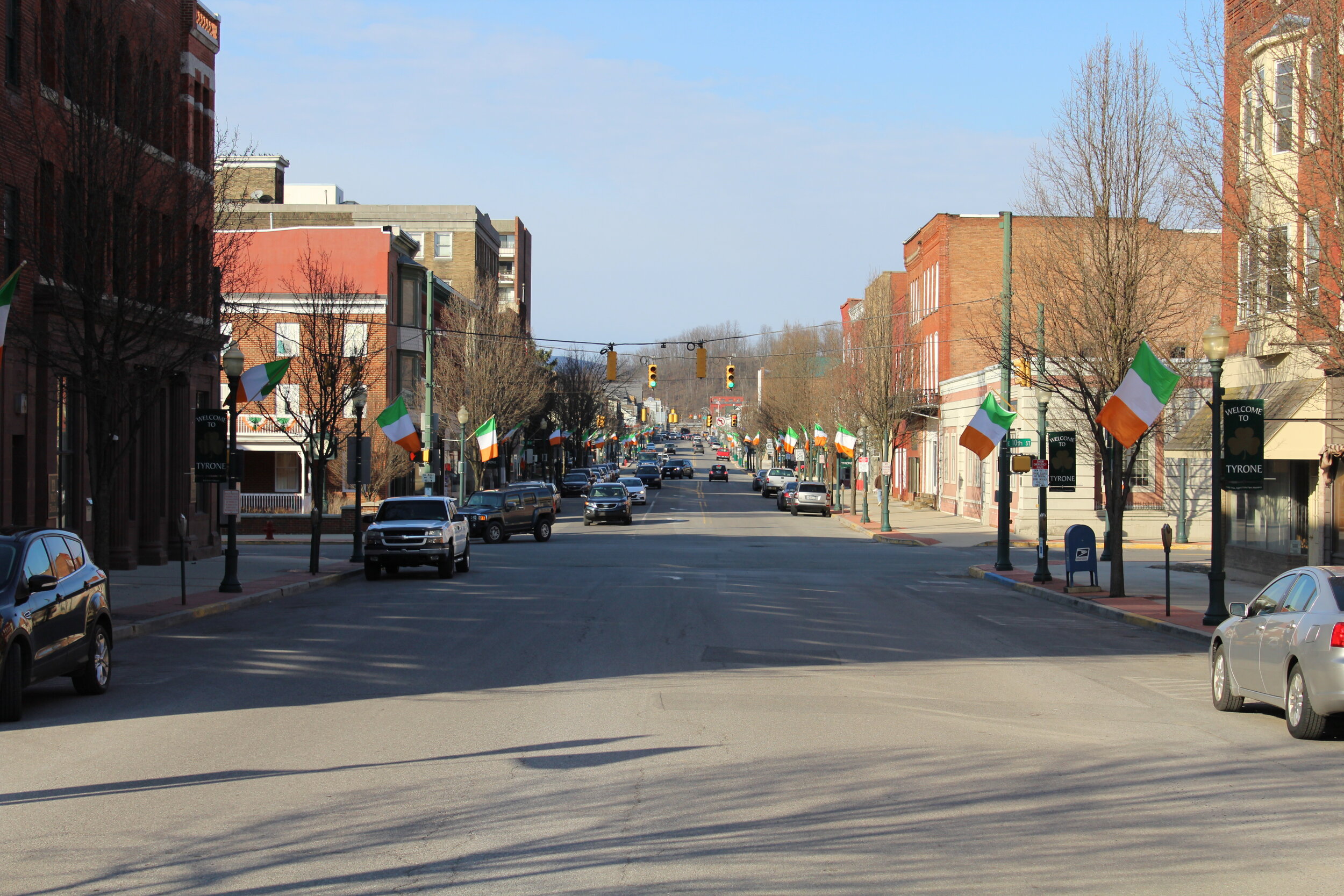
Learn About The Borough of Tyrone
Tyrone’s History
Local Information
Tyrone population: 5,254
Tyrone Area: 1.4 Square Miles
Principal Industries: Chicago Rivet & Machine Company, Gardner’s Candies, Albemarle Corporation, Dixon Tool & Die, Juniata Packing/Kunzler and American Eagle Paper Mill
Tyrone Elevation: 1100 feet; average ridge elevation in the vicinity is 1600 feet
Rivers: Little Juniata River, Bald Eagle Creek
Principal Soil: Weathered sandstone & shale (some limestone)
Forests: Ridge – Oak & Hickory, Valley – Beech, Maple, & Hemlock
Wildlife: white-tailed deer, wild turkey, black bear, gray squirrel, ruffed grouse
Tyrone’s first public (government) building was erected in 1857. A brick, two-story building was later erected on 10th Street. The Citizens Fire Co. used the first floor, and the Borough Council occupied the second floor.
In 1916, Tyrone Borough constructed the present building at 1100 Logan Avenue for its headquarters. The builder was J. Van Hildebrand, and the cost was $24,640. The architect was W. F. Wise. When the building was dedicated, all businesses closed at noon so that the people could attend the ceremony.
The Municipal Building stands on the former location of the National Hotel (1870s), the Constitutional Amendment Hotel (1880s), and former private homes.
On July 27, 1857, by order of the Court, Tyrone was incorporated as a Borough. At this time, the community had a population of about 700 and was part of Snyder Township.
It was the anticipation of greater community growth through the development of the railroad in this area that prompted Tyrone residents to take the action of incorporating into a Borough. The almost immediate need to make street improvements was apparent, and it was the feeling of the residents that this could not be done while the community was part of the township.
History shows that “Tyrone” was the community’s fourth name. The settlement was first called Eagleville, since the Little Bald Eagle flowed through the community; later, Shorbsville, because the land originally belonged to Lyon, Shorb and Company; then, in 1852, the community was called Tyrone City. This was shortened to “Tyrone” when the petition was sent to court.
On August 11, 1857, the Borough had its first election. Jonathan Burley was elected Burgess and Samuel Berlin, William R. Maxwell, John D. Bell, Caleb Guyer and J. W. Jones were elected Councilmen.
The first Borough Council of five men has changed over the years. In the very early years the Borough had two representatives from each of the Borough’s seven wards. Today, Council consists of seven Council members elected “at large” from throughout the borough. In 1972 the first woman, Virgie Werner, served on Borough Council. Ms. Werner was appointed to fill a vacancy and was elected to the position after serving her appointment.
In the early 1960’s, in order to conform to the State Borough Code, the title “Burgess” was changed to “Mayor”. In 1998, Tyrone had its first woman Mayor. Former Mayor Patricia Stoner served two consecutive terms for a total of eight years.
In May of 1981 the local electors of Tyrone Borough selected a seven member Government Study Commission. This group was charged with the responsibility of examining the current form of government used by the Borough. They were also charged with the job of looking at other possible forms of government that might prove to be more effective and efficient. After much study, interviews and public hearings, the Commission recommended that the following question be submitted to the voters of Tyrone Borough at the primary election held on May 18, 1982.
“Shall the Home Rule Charter contained in the Report, dated March 15, 1982, of the Tyrone Borough Government Study Commission, prepared in accordance with the Home Rule Charter and Optional Plans Law be adopted by the Borough of Tyrone?”
The result of the Election was in favor of Tyrone Borough government changing to The Home Rule Charter. This is the form of government we use today.

